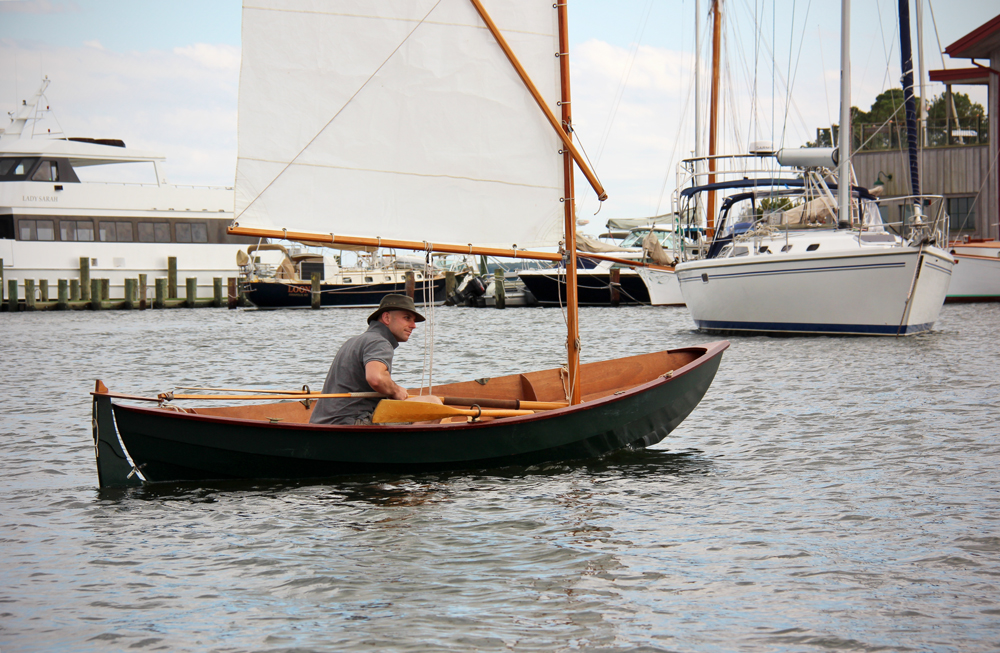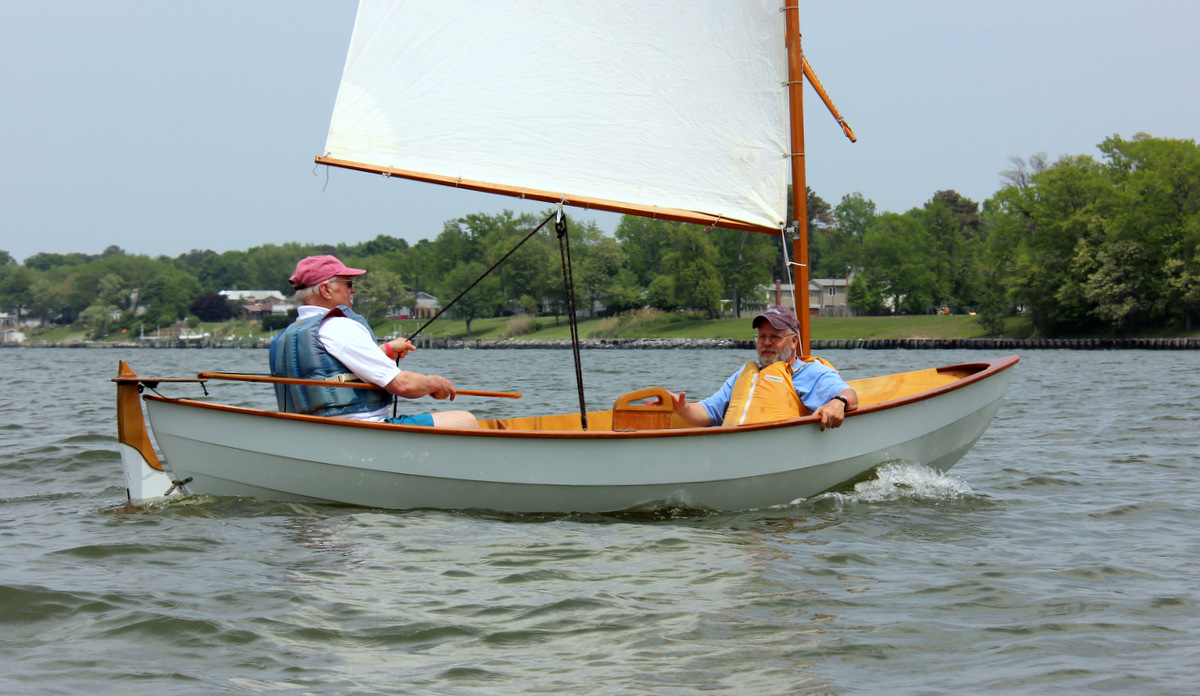Builders' Forum |
|
| ↓ Scroll to Last Comment ↓ | Forum Guidelines | Builders' Forum | |
Rigging a skerry spirt rig for the first time
hi, I was just recently given a skerry spirt rig by a man I met which is in need of some work. Being 17 and hardly knowing anything about boat building or sailing itself I’m pretty dumbfounded on how I’m supposed to rig the sail, I’ve got the correct line needed to rig it but I’m honestly just not sure where to go from there. Any help would be very appreciated! Thank you!
17 replies:
RE: Rigging a skerry spirt rig for the first time
Congratulations, Frederick! 4 more years and you can stop being a pirate (unless you were born in a Leap Year?). Sorry, boats and Fredericks always make me think of pirates :-)
Anyway, a bit more seriously, there's only 3 lines, occasionally 4, on a sprit rig. Here's some photos from the Skerry gallery that show how they're used. Note that you can click on them to get a larger view.
In the first picture, the black lines are the sheet, used to control the boom. There's a block (pulley) tied to the boom and one (not visible) attached to the thwart (seat). One end of the sheet is attached to the boom block, led through the thwart block, then back up and through the boom block and from there to the sailor's hand. This gives the sailor a 2:1 mechanical advantage (purchase), useful in a strong wind. In the good old days of wooden ships and iron men it was known as the "gun tackle"
Moving forward, there's a white line in the front corner (tack) of the sail that goes down along the mast. That's the downhaul, used to adjust the tension along the front vertical end (luff) of the sail. The tension helps give the sail a nice clean aerodynamic leading edge.
You can see the same lines in the next picture, just in mirror image. You can also see the last line, the snotter. It goes from the lower tip of the sprit to a block on the mast and then down along the mast. By supporting the end of the sprit, it moves the top corner of the sail (peak) up and down. The snotter needs a fair bit of adjustment, sometimes a lot of tension, so some kind of tackle with a purchase better than 1:1 and a cleating mechanism is useful. However, for a first try, both the downhaul and snotter can be simply cleated to the mast.

The 4th line is a brailing line and requires a grommet in the trailing edge (leech) of the sail. Since the standard Skerry sail doesn't have one of those, I'm going to let you look that one (along with the rarely used "peak vang") up yourself.
Hope this helps,
Laszlo
RE: Rigging a skerry spirt rig for the first time
Hello,
I am also a new Skerry owner, although I bought mine used. This is my first sailboat and I am having a blast.
A question about the rigging: on most pictures I see the main sheet going from the block on the boom to one's hand. In a few pictures, it seems that the sheet exits the bottom block and then to one's hand. Is there a right way? Advantages to either one or another? My boat only came with one block, so I have been at 1:1 with a rather thin sheet. It was not ideal. I have bought some thicker line and another block.
Keith H
RE: Rigging a skerry spirt rig for the first time
Hey Keith,
The right way is what works for you.
Thicker line is definitely easier on one's hands, especially if you don't have a good set of gloves or calluses.
The increased mechanical advantage of a 2:1 purchase reduces fatigue, but at the cost of more line in the cockpit. If it's getting to look like a snakepit in there, you can also use a ratchet block. In that case, the single sheet line comes from the boom, through the block on the thwart and to your hand, like what you mention seeing in the pictures.
Ratchet blocks are very nice in that they hold the line without straining your arm but allow instant release in case of a gust. Their downside is their cost. The one CLC sells is competitively priced, but it's still $80. But if you only need one it's not too bad and will make your sailing much more enjoyable and remove the temptation to cleat the sheet in a small boat (never a good idea).
Have fun,
Laszlo
RE: Rigging a skerry spirt rig for the first time
Thanks Laszo.
That ratchet block seems like the answer. As always, one more thing to buy.
When you say it's never a good idea to cleat the main sheet, are your referring to jam cleats?
Keith
RE: Rigging a skerry spirt rig for the first time
The trouble with jam cleats is they can...well...jam. Things happen quickly while sailing small boats. That's much of the fun, of course, but it means you need to be ready to react very quickly when Gusty, Puffy & Shifty come out to play, and keeping the mainsheet in hand is a big part of that.
The trouble is you kinda need three hands. You've got one hand on the tiller, one hand on the sheet, and the other hand reaching for a drink of water...oops, we're already a hand short. So, you need to get clever about how to hold the sheet briefly, once you've gotten it hauled in as desired, in ways that don't involve gripping it in your fist so you can briefly use that hand for something else.
If you have a ratchet block in the mix and enough mechanical advantage in your sheet arrangement to keep the effort needed to hold the fall fairly light, your teeth can stand in for a hand briefly. My grandchildren tease me about it, saying, "Dang, Gramps, if your teeth ever go, you'll have to quit sailing!" This can be useful when you need to haul in the sheet after spilling off a gust, when you need something to hold the first fetch while you reposition your hand to get in some more. Pinching the fall between a knee and the thwart or between a toe and the daggerboard case can work for that, too.
Sometimes you can position the fall so your tiller hand can grip that and the tiller both while using your non-tiller hand to haul some more sheet in, get at the water bottle, scratch your nose, push up your sunglasses, or whatever. Maybe that's why some folks prefer to lead the sheet from the boom end instead of the middle, so as to have the fall come down where the tiller hand can be used that way more readily.
All of this takes some thought and practice so that you don't have to think about shat to do when a gust tries to snatch your hat off your head.
.....Michael
RE: Rigging a skerry spirt rig for the first time
What Michael said. Any kind of cleat is a bad idea for a Skerry. You don't want to be cleating a sheet unless the boat is large enough so that the maximum likely gust for the day won't flip it before you can get it uncleated. The Skerry's too small for that kind of thing, especially since it's unballasted.
Laszlo
RE: Rigging a skerry spirt rig for the first time
Thank. Good reads. I have certainey noticed the need for additional appendages. Like when fishing the tiller out of the water. Or an oar. One time even the Sprit.
RE: Rigging a skerry spirt rig for the first time
Thanks Laszlo for the recommenation for the ratchet block. That made a world of difference!
Keith H
RE: Rigging a skerry spirt rig for the first time
... and that ratchet block, when mounted somewhere past mid-beam, earned the nickname "head-knocker" for good reason, so beware... beware.
RE: Rigging a skerry spirt rig for the first time
Unless you attach the block to the thwart and lead the sheet from the boom to the block to your hand. Then the ratchet block stays put and your head is safe. Your nether regions are another story...
Laszlo
RE: Rigging a skerry spirt rig for the first time
On my PMD, with a two-part sheet setup led from mid-boom (lower yard, really, on a lug sail) to a very short bridle on the midship thwart (as shown in the PMD manual), I went a different route. I left the fiddle block on the bottom with the turning block above, but led the fall of the sheet forward from the lower block to the ratchet block, which I lashed to the lower part of the mast with the swivel loose that that it would pivot whichever way needed, and thence back to me. Takes a bit more sheet, but I still had a lot of that even after cutting down the over-long piece supplied in the rigging kit from CLC. Keeps the ratchet block stationary and out of the way unless I have a passenger forward, in which case I'd rig up something else. In light air, I leave the ratchet block out of the mix.
It's a different story if you're sheeting to the end of the boom, of course....
.....Michael
RE: Rigging a skerry spirt rig for the first time
I hope one day day to be able to read that paragraph and have a clue. Not there yet.
Keith
RE: Rigging a skerry spirt rig for the first time
I don't have a picture of my PMD sheet set up with the ratchet block in place as described (perhaps not very well) above, but here's a link:
https://www.dropbox.com/s/y5s95kb6otntu1l/160_K30b2063a.jpg?dl=0
...to the sheet set up pretty much as indicated in the PMD manual. That's a becket block on the lower end of the tackle, not a fiddle block as I erroneously stated above--getting squirrel-brained in my old age, I guess, or maybe Old Father Time has been shuffling my dictionary flash cards.
Anyway, you can see how the upper block attaches to middle of the lower yard, and how the fall of the sheet (the part you pull on) exits on the after side of that lower block. When I want the ratchet block in the mix, I'll rig this the other way around so that the sheet exits the lower becket block pointing forward, and I'll lead the sheet through the ratchet block, which will be lashed to the mast somewhere below the halyard cleats, and thence back where the helmsman can reach it. The ratchet block has a swivel so it can flip as needed to lead fairly as I move the sheet from one side to the other when tacking or gybing.
Hope that helps.
.....Michael














RE: Rigging a skerry spirt rig for the first time
» Submitted by spclark - Sun, 8/18/19 » 7:48 PM
Lucky you, Frederick!
To be 17 and even know someone who’s built a Skerry would be fun in my book!
(I was 22 when I began my first boat-building project, knowing nothing about sailing and little to nothing about wood-working, at least as to how it applied to something besides furniture.)
That your friend has given you his project is an exceptional measure of his trust in you.
I’m confident there’ll be others here who can assist you. Some may even be close by!
Where might you be located?